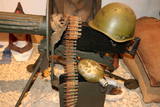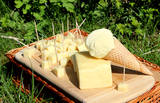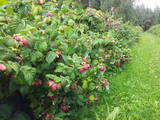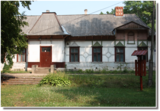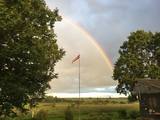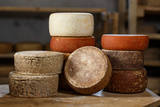Kontaktinformation
Related objects
| Foto | Name | Beschreibung |
|---|---|---|
|
Die Hauswirtin stellt Käse und Rauchfleisch her. Empfängt die Besuchergruppen und Einzelbesucher. Die Erzeugnisse kann man auch in Riga kaufen. |
||
|
Found at Daugavpils Street 40 in Aglona, this is one of the largest private collections of military exhibits related to World War II in
|
||
|
Auf den weiten Wiesen der Wirtschaft weidet an den Ufern des Flusses Aiviekste die größte Herde der Lettischen Schwarzköpfigen Schafe (~ 400 Tiere) in Lettland. Besichtigung der Wirtschaft. Hier kann man Schafe, Fleisch, Wolle, Felle und Gemüse kaufen. |
||
|
Hier kann man eine breite Sammlung an alten Musikinstrumenten besichtigen. Die Besucher können den Erzählungen über die Geschichte und Herstellung von Musikinstrumenten zuhören, sowie selbstgemachte Musikinstrumente bestellen und kaufen. Mit vorheriger Anmeldung kann man das Konzertprogramm der Kapelle der Familie von Igaunis anhören. |
||
|
Hier wird Viehzucht, Obstbau und Gemüsebau betrieben, sowie Milch und Fleisch erzeugt und verarbeitet. Die Wirte teilen ihr Wissen, wie man Käse (auf offenem Feuer) kocht und macht. Hier werden Brot nach Rezepten der Vorfahren gebacken und Hochzeitsfeiern nach den lettgallischen Traditionen angeboten. Lettische Küche: Roggenbrot, 14 verschiedene Käsesorten, Bauernsuppe, hausgemachtes Bier und eine Vorführung des Bierbrauens. Das besondere Gericht: Gefüllte Kartoffelpfannkuchen Gulbešnīki mit Pilzsoße. |
||
|
Auffällig sind die beiden 60m hohen Türme des im Barockstil erbauten Gotteshaus. Die Kanzel, der Orgelprospekt, die Orgel und ein Beichtstuhl stammen aus dem 18. Jh., die Seitenaltäre vom Beginn des 19. Jh. Im zentralen Teil des Altars befindet sich das Gemälde „Die wundertätige Gottesmutter von Aglona aus dem 17.Jh., dem Heilkräfte zugesagt werden, daher wird es nur zu bedeutenden Zeiten gezeigt. Vor dem Besuch des römischen Papstes Johannes Paul II in Lettland im Jahre 1993 fanden umfangreiche Renovierungs- und Umbauarbeiten am Kirchenkomplex statt. Alljährlich kommen am 15. August Pilger nach Aglona, um das Fest Mariä Himmelfahrt zu feiern. Etwa 100m von der Basilika befindet sich die heilige Quelle Aglonas Svētavots. |
||
|
Dieser Hof ist ein authentischer Hof aus dem Anfang des 20. Jhs. mit einem Wohnhaus, einer Kornkammer, einem Stall, einer Sauna und einer Schmiede. Hier kann man den Vorführungen einer Folkloregemeinschaft zuschauen, die Sommersonnenwende feiern, an Jahrmärkten des Tages von Mikelis (Herbstsonnenwende) teilnehmen und verschiedene Gewerbe erlernen. Lettische Küche: Klöße, Graupen mit verschiedenen Zutaten, selbstgebackenes Brot, Butter, Käse, Kräutertees und das lettgallische Hausbranntwein Šmakovka. Das besondere Gericht: Brot von Andrupene. |
||
|
Im Hof werden verschiedene ländliche Leckereien zubereitet – Käse, Käsestangen u.a. Biologischer Landwirtschaftsbetrieb, in dem man selbst angebaute Podukte verwendet. Verkostungen und Erwerb von Podukten, Exkursionen für die Gruppen ab 10 Personen. |
||
|
The first wooden Catholic church in Dagda was built in 1705, while the church that is seen today was built in the Baroque style during the latter half of the 18th century, the work financed by a local nobleman. Important interior elements include the altar, the pulpit, the organ, a monument to the Hilsen dynasty, etc. To the North of the church is historical Dagda itself, with typical red brick buildings from the early 20th century that are known as the former homes of Jewish merchants.
|
||
|
Ein Cafe auf der Sommerterrasse, befindet sich auf dem Strandgelände des Parks von Preili. Das Cafe bietet ein 100% natürliches hausgemachtes Eis mit Beeren an. Vor Ort werden frische Pfankucken "Pampūkas" gebacken. Das Strandcafe ist nur vom Mutterstag (der 8. Mai) bis zum Vatterstag (der 11. September) geöffnet. Für die Touristengruppen – Exkursionen und Verkostung vom Käseeis. |
||
|
The Ataugas farm *Object Inactive*
|
The farm grows raspberries and strawberries, and you can pick and buy berries and also purchase plants. You can take a tour of the farm and receive consultations. Groups of no fewer than ten people can take part in the baking of countryside sourdough bread. You will learn how to knead the dough, make a loaf and churn butter, and then you will be able to taste the freshly baked bread. |
|
|
In dem Museum wird der Weg des Brotes von dem Korn bis zum fertigen Brotlaib geschildert, den jeder selber formen kann. Die Besucher können Brot (mit Kräutertees) verkosten und einer theatralischen Vorführung über jede Lebensangelegenheit – Taufe, Hochzeit, Jubiläum u.a. – zuschauen. Bei der Mahlzeit werden auf den Tischen Klöße, Krapavnīks, eine Suppe aus getrockneten Pilzen oder aus Fischen aus dem See gelegt. Mit vorheriger Abmeldung nimmt bei der Veranstaltung auch eine Volkstanzgruppe an. Lettische Küche: Suppe aus Seefischen, Klöße und Gericht Krapavnīks. Das besondere Gericht: Suppe aus getrockneten Pilzen. |
||
|
In der geerbten Wirtschaft (Wohnhaus aus Holz mit dekorativen Zargen und Fensterläden) stellen die Wirte nach alten und modernen Rezepten Käse aus der Milch her, die aus den auf diesem Hof gezüchteten Kühen gemolken wird. Die Besucher können hier Milch, Sauermilch, Buttermilch und andere Milchprodukte verkosten, sowie den Herstellungsprozess beocbachten und an dem Prozess teilnehmen. |
||
|
The small Andrupene swamp is found to the North of the Andrupene Farm Museum in a deep area between hillocks. It is a high-type swamp with an open central part, and it is 130 m long and 120 m wide. There are stands of white alder alongside the swamp. In 2009, the administrators of the Rāzna National Park restored a wooden educational pathway that had been established originally by the Andrupene Elementary School. Today there are stairs, a viewing platform, wooden pathways, and information stands. |
||
|
Zosna (Veczosna) Manor. The building is surrounded by a small park near the bank of Lake Rāzna.
There are 39 different species of trees and bushes. It was built in 1870 by the order of duke Goļicins. It is
one of the rare truss buildings in Latgale.
|
||
|
Der Hof "Upenite" befindet sich am südlichen Ufer des Sees Cirisa ezers. Ein ausgezeichneter Bio-Hof, auf dem lettgallische Traditionen gepflegt, Milchprodukte (auch Käse) hergestellt, einheimische Kulturpflanzen (diese kann man auch erwerben) angebaut und die lettgallische Rauchsauna angeboten werden, in der als Saunameister die Wirte arbeiten. Meisterkurse im Backen von Torten organisiert. Lettische Küche: Bauernsuppe (Fleischbrühe mit Grützen), gefüllte Kartoffelpfannkuchen Gulbešnīki, Kartoffelwürste (geriebene unreife Kartoffeln mit gebratenem Schweinfleisch und Zwiebeln), schwarze Johannisbeeren mit Schlagsahne, Kümmelstangen, Kräutertees, Quark mit Sauerrahm, Pfannkuchen aus Sauermilch. Das besondere Gericht: Im Ofen gebackener Karpfen oder gebackene Schleie aus dem eigenen Teich. |
||
|
The farm uses ancient recipes from grandmothers to bake aromatic sourdough and rye bread on maple leaves, with the crunch crust being processed with flax oil. You can help to bake the bread and then taste and buy it. |
||
|
Diese Stadt ist das Herz der Region Latgale, wo vom 9. bis 12. Jh. eine hölzerne Burg der Letgallen sich erheben hat. Im Jahr 1285 hat der Livländische Orden begonnen, an der Stelle dieser Burg eine gemauerte Burg zu bauen. Nach dem Zerfall des Livländischen Ordensstaates verkümmerte die Stadt (Rēzekne war ein Teil von Polen). Das wirtschaftliche Leben wurde in der zweiten Hälfte des 18. Jhs. wieder aktiv. Nach dem Ausbau der Straße (1836) und der Eisenbahn (1861) zwischen St. Petersburg und Warschau wurde Rēzekne zu einem Reiseziel für Urlauber aus St. Petersburg. Während des Zweiten Weltkriegs wurde die Bebauung der Stadt wesentlich zerstört. Heute ist die Stadt ein bedeutendes Zentrum für Wirtschaft und Kultur der Region Latgale. |
||
|
Cafe „Papardes zieds” *Object Inactive*
|
Ernährungsmöglichkeiten sowohl für die Einzelbesucher als auch für die Gruppen. Nach Vorbestellung – gefüllter Hecht, Krebs- und Aalgerichte (aus den lettgallischen Seen). Teilnehmer des kulinarischen Erbes Lettgallens. Die Bezitzerin Marija Aleksejeva ist ein Mitglied des Käserverbands. |
|
|
Andrupenes dabas takā var iepazīt sūnas, pārliecināties par sfagnu lielo ūdens uzsūkšanas spēju, gar laipas malām ieraudzīt apaļlapu raseni un purva dzērveni, apskatīt spilves, vaivariņus un purva vārnkāju, kā arī purva pasauli. Takas garums ~ 750m.
|
||
|
The Preiļi Estate is in the southern part of Preiļi. During the Soviet era, the mansion was home to a variety of institutions. A fire burned much of the upper part of the building in 1978. The mansion was never restored, and it can only be viewed from the outside. Around it, however, is one of Latvia’s most outstanding landscape parks (mid-19th century). Irēna Kjarkuža offers interesting tours of the state, with interesting legends and songs in the Lettigalian language. |
||
|
This farm is run by a young family which left the hurly-burly of
|
||
|
The tower is on the western shore of the lake, next to the dam and the Zvidze canal. From here you will see the overgrowth north-western part of the lake, Akmeņsala Island, and a wide area of open water. The third is on the southern shore of the lake, by the dam and the Īdeņa canal. Here you will find typical views of wetlands – areas of reeds, shrubbery, wet meadows and the overgrown lake. |
||
|
Antons Rancans produces wooden busts of well known people from politics, the arts and other fields of endeavour, and these can be purchased. Visitors can also commission decorative objects that are produced from wood. The artist also produces crucifixes. Gundega Rancāne is a landscape painter who is renowned for her masterful use of light and shadow. Her works are available for purchase.
|
||
|
Biologischer Landwirtschaftsbetrieb, der Ziegen züchtet und Käse herstellt. Verschiedene Ziegenkäse- und Kuhkäsespezialitäten. Im Landwirtschaftsbetrieb sind ca. 100 Melkkühe. Die Besitzer Ruta un Stefan (Sprechen lettisch, deutsch, englisch) warten auf die Besucher. Käsespezialitäten kann man vor Ort, auf dem Markt im Kalnciema-Viertel in Riga und andernorts in Lettland kaufen. Produktion – Ziegen- und Kuhmilchkäse. Es werden eine Führung durch den Bauernhof und die Käserei und eine Verkostung angeboten |
||
|
The potter produces candelabras, dishes and whistles that you can buy at the workshop. She also accepts commissions for new products. You can work with your own clay and take the resulting product home with you as a souvenir. |


